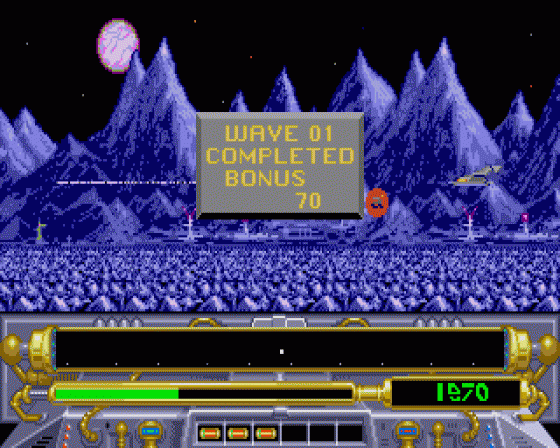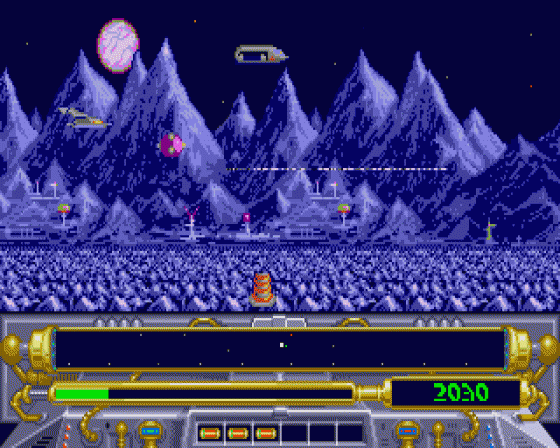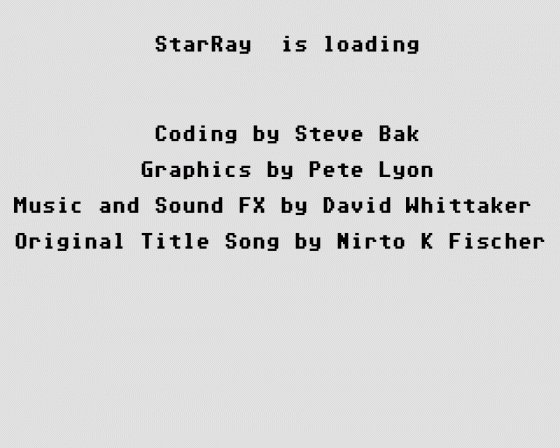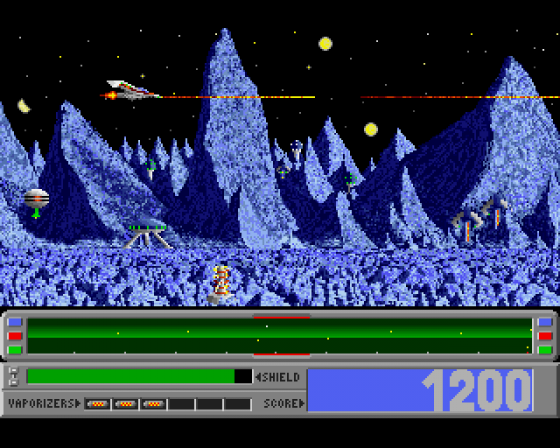
The One
 1st October 1988
1st October 1988
Categories: Review: Software
Author: Gary Whitta
Publisher: Logotron
Machine: Amiga 500
Published in The One #1
Williams' timeless coin-op classic Defender has often been imitated but never surpassed. Or has it? Logotron's Star-Ray is a slick adaptation of the age-old formula, and Gary Whitta is the man with his fingers on the buttons...
Star Ray (Logotron)
There can hardly be a games enthusiast who has never heard of Defender. It may not have spawned as many clones as more recent games such as Gauntlet or Arkanoid, but the original concept remains one of the most innovative and playable in history. The basic idea of skimming over a line-drawn landscape shooting miniscule aliens and rescuing tiny one-colour humanoids may not sound like classic game design, but the fact that there were five key controls to master (the joystick was only used for up and down) meant one hell of a challenge for even the most hardened gamers.
Now 16-bit owners who never experienced the phenomenon first time round can try for themselves what is best described as Defender '88. Star-Ray takes the original framework of Defender and brings it up to date utilising the power that 16-bit machines have to offer. The scenario (for what it's worth) casts you in the role of a starship pilot, just out of combat academy and assigned to your first mission. In control of the latest Star-Ray space fighter, you must thwart the impending attack by an evil race of aliens who plan to cause as much trouble as possible on seven planets.
That rather lame plot is the excuse for 28 levels of pure frenetic blasting action, pitching you against a never-ending supply of aliens. Each level, or planet, houses ten installations that provide all the power for the planet. The alien's mission is to raid these installations by landing on them, and sucking all the power.

Your Star-Ray fighter is equipped with two different types of weaponry. A laser cannon is mounted onto the front of the ship, and a stab of the fire button sends a colourful streak of electric death flying horizontally across the screen, eradicating any nasties in its path. Your ship is also supplied with a small complement of Vaporisers, otherwise known as Smart Bombs. Releasing one of these destroys every hostile ship on the screen.
Controls are fairly basic. By pushing the stick in the direction your fighter is facing, you apply thrust. The ship stays fairly central while the backdrop scrolls behind. In this way, the "thrust and blast" gameplay of the original has been retained. In order to leave each level alive, fifty to speak, the installations need protecting. Locate the nasties that are actually attacking the installations (the radar scanner comes in useful here), get to it and destroy the alien before it has a chance to drain the installation's power. If you're too late, an installation is lost. To make matters worse, on later levels, drained installations become hostile, firing at you and launching missiles. Should you lose all ten installations, the game is lost.
A much quicker way to lose the game, however is to get killed yourself. Unlike Defender, a collision with a nasty or a missile is not fatal. Instead, you're given a shield which is depleted every time you crash into something. When it hits zero, you're dead.

To complete the level you're on, all the nasties on it with you must be destroyed. There are four 'waves' of aliens on each planet, and completion of each one results in a points bonus, of which being dependent on which level you're on and the number of installations left.
Each planet has its own specific set of resident aliens and game features. Level Two, for instance, is set in a forest, and houses deadly striped killer bees. All of the levels contain one standard set of aliens that run throughout the entire game - the metallic hamburgers. If you're lucky, when you shoot one of these (or any other kind of alien for that matter) they may leave behind a floating icon, which can be picked up to power-up your ship. If you want to replenish your shield, you have to wait for an airbus to appear. When shot, a pod falls from it, and if you can catch it before it hits the ground, the feature is yours.
ST
The ST version of Star-Ray is being converted by 16-bit maestro Stave Bak, the man responsible for Leatherneck, Goldrunner and Return To Genesis, as well as converting The Sentinel and Battleships among others to 16-bit. Graphics are by colleague Pete Lyon, and binary musician Dave Whittaker supplies the music and FX. The job of conversion has been done very well indeed. Graphically, the game looks a little 'hazy' and the sprites are not quite as well-defined, but all the original gameplay is there, and several extras have been added.

Whilst the Amiga has five levels of parallax scrolling, the ST has seven! There are also more aliens than the Amiga version and there's an option to play the soundtrack while playing the game. Atari 1040 ST owners will also be able to get on down to the brilliant sampled soundtrack which takes up over 300K and sounds almost exactly like the Amiga original. A release date is set for around September, possibly in time for the PC Show.
Amiga
Defender fans have never had it so good. Star-Ray is unquestionably one of the best shoot 'em ups to appear on the Amiga to date. What Logotron have done with Star-Ray is very similar to what Taito did with Breakout to produce Arkanoid, i.e. the classic formula is still there, and has been improved no end due to the addition of fantastic graphics, incredible sound and some new gameplay elements. Both the backdrops and sprites have been wonderfully defined and animated, and each level implements some most impressive parallax scrolling which helps to generate an excellent feel, making it no less than a joy to play.
To add to the overall impression, the sampled in-game effects have been complemented by an atmospheric loading theme, and great high score table music. Presentation is first class, with plenty of options so you can tweak the game to your liking. You can play in silence, making it faster in the process, start on any of the first four levels and save your scores to disk. My only gripe is that the Smart Bombs can only be activated by the right mouse button, which is fine if you're playing with the mouse, but not so convenient if you're using a joystick.
Minor quibbles aside, Star-Ray well and truly replaces Sidewinder as the best Amiga shoot-'em-up available. Buy it, lock your door, close all your windows and immerse yourself in this fantastic blast.
PC
Information on the PC version is rather vague, as it's in the very early stages of conversion. It's likely to be in mono to allow a fast game speed, so all the gameplay should be retained. A finished version of Star-Ray is due for release on the PC in November.
Other Reviews Of Star Ray For The Amiga 500
Star Ray (Logotron)
A review
Star Ray (Logotron)
A review by Julian Rignall (C&VG)
Star Ray (Logotron)
A review by Mike Pattenden (Commodore User)
Other Amiga 500 Game Reviews By Gary Whitta
Scores
Amiga 500 Version| Graphics | 86% |
| Sound | 94% |
| Playability | 90% |
| Value For Money | 80% |
| Overall | 88% |
Scores
Atari ST Version| Graphics | 86% |
| Sound | 94% |
| Playability | 90% |
| Value For Money | 80% |
| Overall | 88% |
Scores
Amiga 500 Version| Graphics | 86% |
| Sound | 94% |
| Playability | 90% |
| Value For Money | 80% |
| Overall | 88% |
















